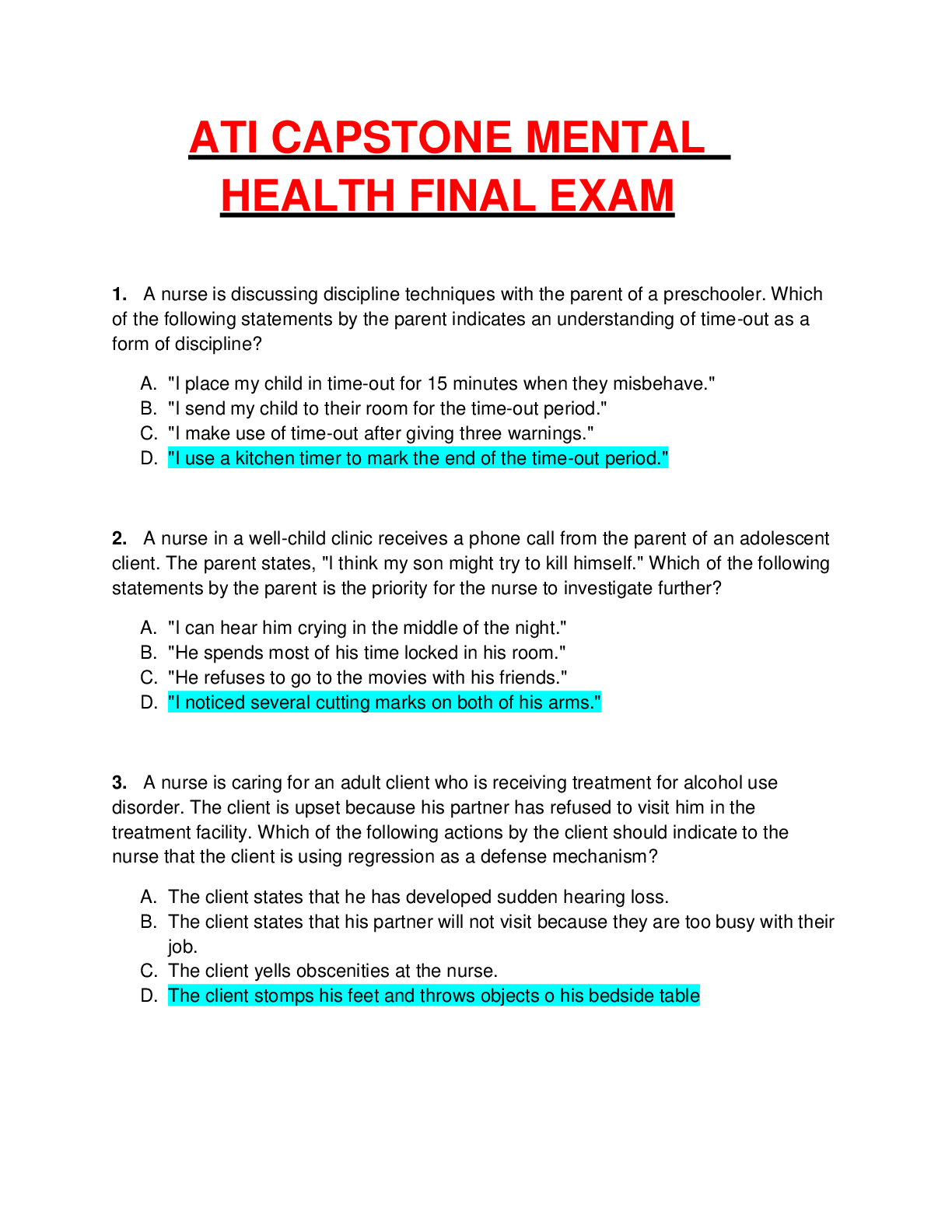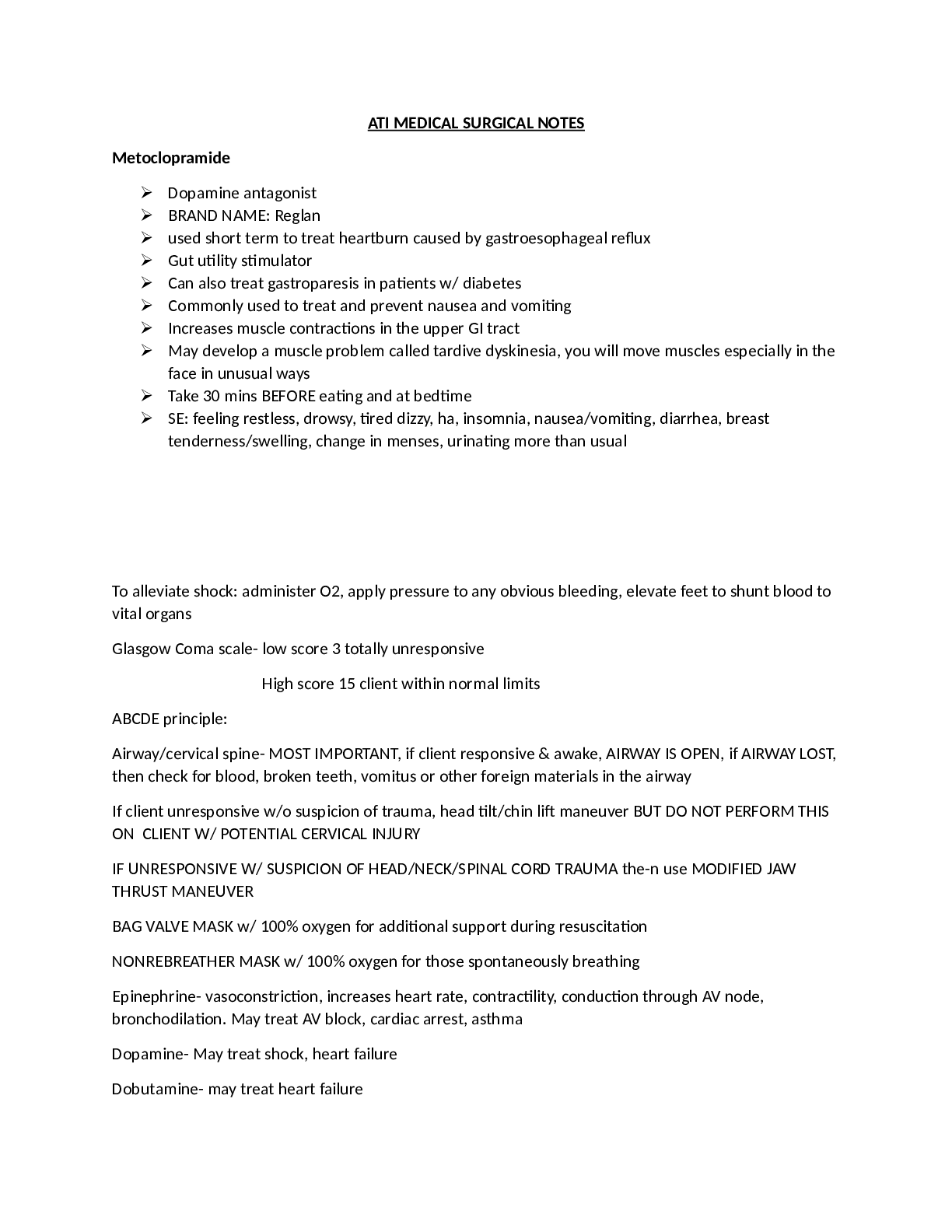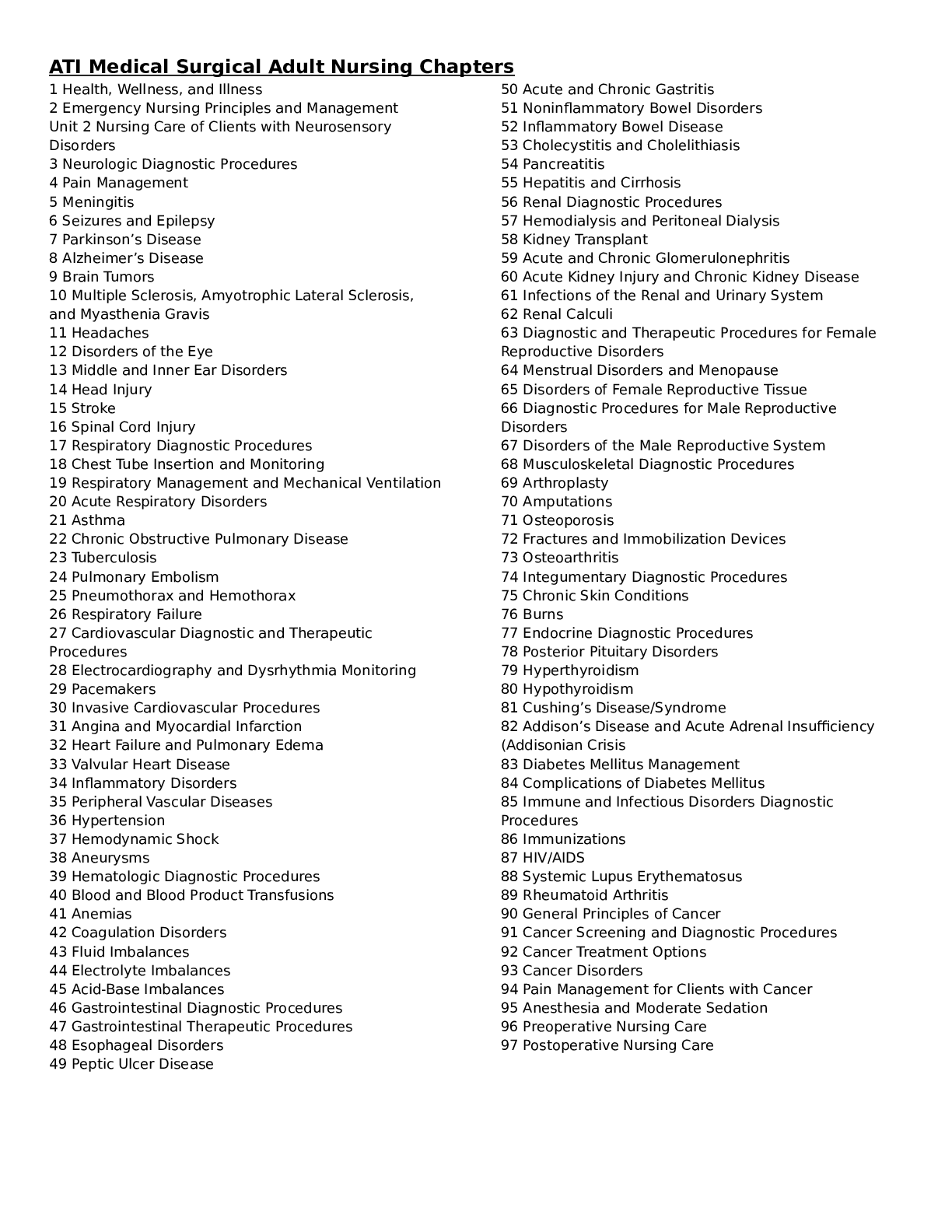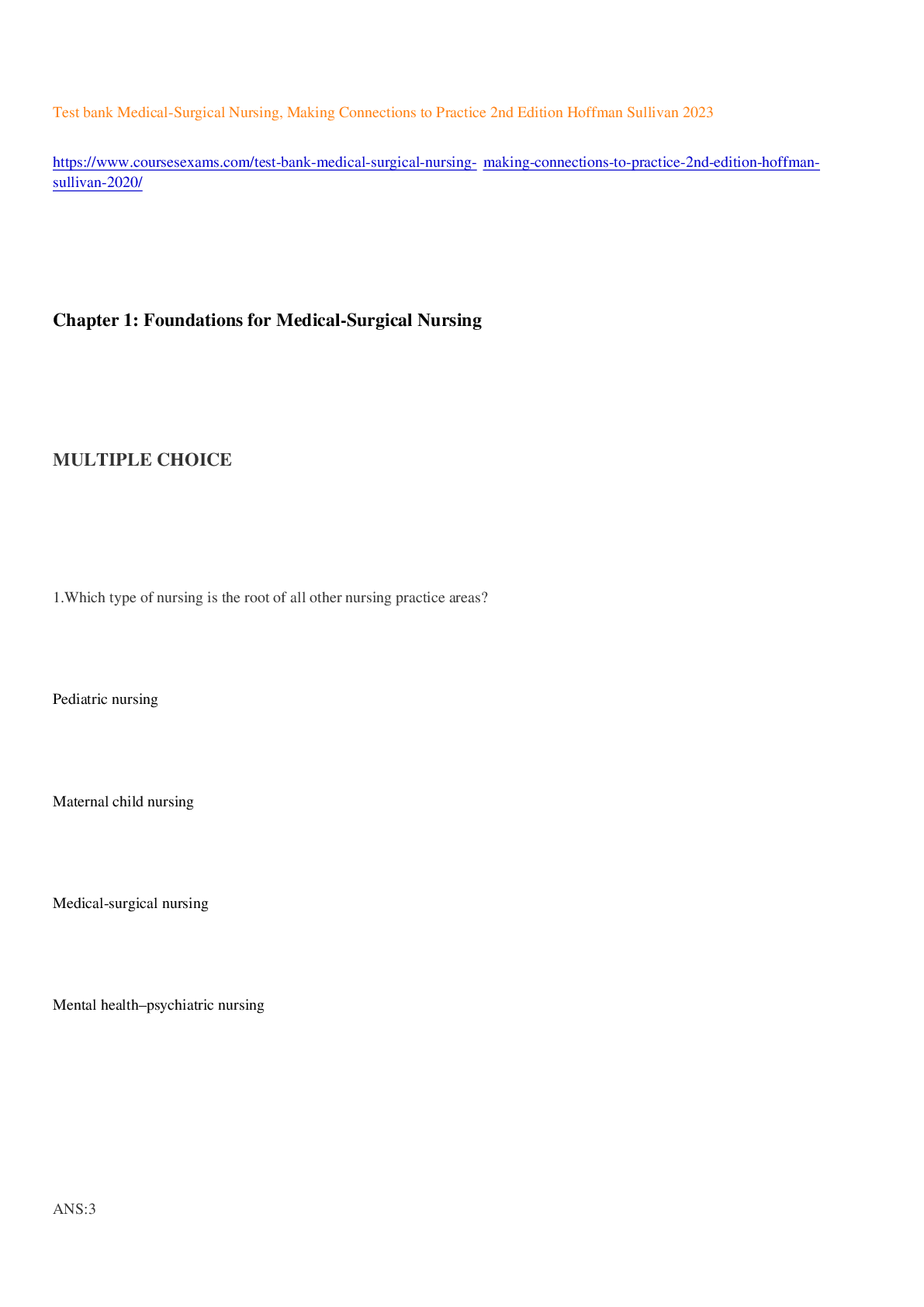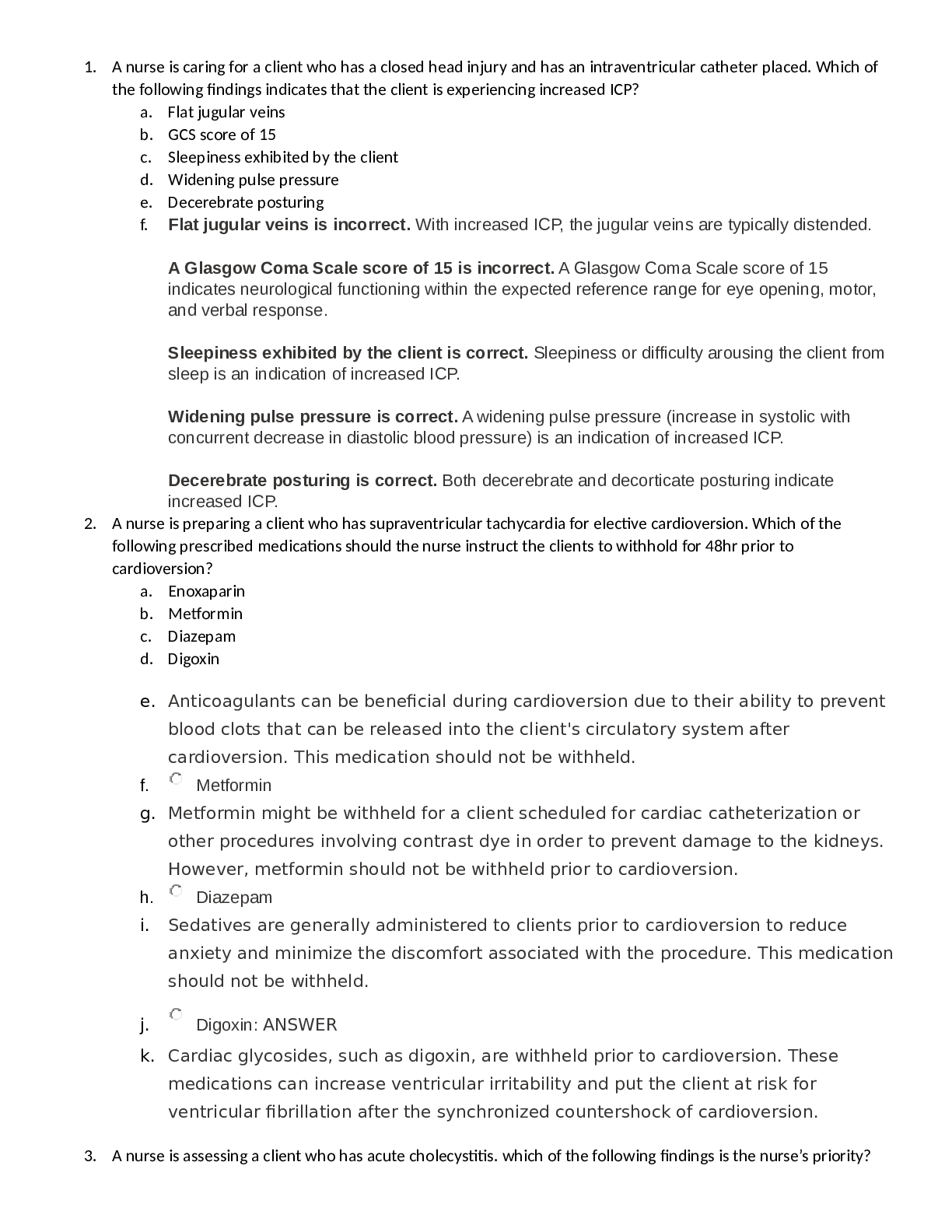*NURSING > ATI MEDICAL SURGICAL > NURS 314 ATI Medical Surgical 2020 – Texas University | NURS314 ATI Medical Surgical 2020 (All)
NURS 314 ATI Medical Surgical 2020 – Texas University | NURS314 ATI Medical Surgical 2020
Document Content and Description Below
NURS 314 ATI Medical Surgical 2020 – Texas University NURS314 ATI Medical Surgical 2020 Medical Surgical: Dermatological 1. A client is prescribed 1% silver sulfadiazine cream (Silvadene) to be a... pplied to her burn wounds twice daily. After 3 days of treatment, the nurse suspects an adverse reaction to the medication when the client develops which of the following? Leukopenia Transient leukopenia is a common adverse effect that appears after 2 to 3 days of treatment with silver sulfadiazine cream. 2. A client with a large healing deep partial thickness burn of the forearm and wrist is being discharged from the burn treatment clinic. Which of the following should the nurse tell the client to avoid for a year? Exposure to the sun A deep partial thickness burn occurs when the first layer of skin, the epidermis, is burned all the way through, and some level of burning occurs in the underlying layer of skin, called the dermis. A deep partial thickness burn can cause permanent scars, much like a full thickness burn. Exposure to sun of the newly formed and healing skin in the year following a burn injury can cause more intense scarring. 3. A nurse on a surgical unit is caring for four clients with healing wounds. Which of the four clints wounds should the nurse anticipate will heal by primary intention? Gastroplasty incision Would closure occurs by primary intention (surgical closure), secondary intention (left open to close by the reparative process), and tertiary closure (left open and surgically closed at a later date). With primary intention, a clean would is closed mechanically, leaving well approximated edges and minimal scarring. A surgical incision is an example of a wound that heals by primary intention. 4. A client is being discharged after surgical excision of a malignant melanoma. Which statement indicated to the nurse an understanding of the danger of ultraviolet light? I’ll reapply my sunscreen every 2 hours when I’m out in the sun. Even water- resistant sunscreens should be reapplied at least every 2 hr after swimming or during prolonged sun exposure. 5. A client is admitted for treatment of malignant melanoma of the left upper leg. Initially, the nurse plans to prepare the client for which of the following? Surgical excision the therapeutic approach to malignant melanoma depends on the level of invasion and the depth of the lesion. Surgical excision is the treatment of choice for small, superficial lesions. Deeper lesions require wide local excision, after which skin grafting may be needed. 6. A client is about to undergo a biopsy of a 6-mm, bluish- red lesion. In addition to a thorough skin examination, the nurse knows the most critical assessment to be made at this time is the status of the clients Regional lymph nodes The description of the lesion suggests a malignant melanoma. The assessment should include not only a thorough skin examination, but also palpation of the regional lymph nodes that drain the area near the lesion. 7. When targeting a group of clients for health teaching, the nurse should be aware that which group is at greatest risk for developing malignant melanoma? Clients who are fair- haired, fair- skinned, and of Celtic descent Clients who have fair hair, fair skin, and blue eyes and are of Celtic descent are at the highest risk for developing skin cancer. 8. A client with an undiagnosed lesion on the back of his right hand is concerned about the possibility of skin cancer. When the client asks what the most serious type of skin cancer is, the nurse responds based on the knowledge that most malignant tumors are Melanomas Melanomas are malignant neoplasms with atypical melanocytes in both the epidermis and the dermis (and sometimes the subcutaneous cells). It is the most lethal type of skin cancer, often causing metastases in bone, liver, lungs, spleen, the central nervous system, and lymph nodes. 9. A client is hospitalized with extensive full thickness burns of both legs. In response to the clients questions, the nurse explains that during the acute phase of burn injury, biological dressings are used primarily to Promote healing Biological dressings are temporary grafts used during the acute phase to increase the rate of epithelialization, act as a barrier to protect the wound from contamination, and reduce fluid and protein loss. 10. A nurse teaches a wheelchair bound client to reduce the risk of pressure ulcer formation by instructing the client to do which of the following? “Shift your weight in the wheelchair every 15 minutes.” This response addresses the safety issue of the risk of pressure ulcers. Pressure ulcers, wounds that develop due to prolonged pressure on a particular point of the body, are most likely to develop if the client does not shift position frequently. 11. A client had had a basal cell carcinoma removed by surgical excision. The nurse instructs the client to watch for indications of potential malignancy in other moles, including which of the following? Ulceration Ulceration, bleeding, or exudation are indications of a mole’s potential malignancy. Increasing size is also a warning sign. The nurse should emphasize the importance of a lifetime follow- up evaluations and the proper techniques for self- examination of the skin every month. 12. A nurse plans to teach a group of young adults health promotion techniques to reduce the risk of skin cancer. Which of the following should the nurse include? Avoid exposure to the midday sun. Avoiding skin exposure, especially during the midday hours of 1000 to 1500 is crucial for preventing skin cancer. 13. A client is brought to the emergency department with severe frostbite. The nurse assessing the client knows the burned appearance of frostbitten tissue is a direct result of which of the following? Red blood cell aggregation with microvascular occlusion As blood reaches freezing temperatures, red blood cells aggregate, or clump together. This causes occlusion of small blood vessels and leads to a loss of superficial blood flow. This causes a discoloration of the skin that resembles a superficial, partial- thickness burn. 14. A client comes to the clinic reporting skin lesions. The nurse assesses the lesions and notes that they are 0.5 cm in size, elevated and solid, with very distinct borders. Based on the finding, which of the following should the nurse document the presence of? Papules A papule is a small, solid, elevated lesion with distinct borders. It is usually smaller than 10 MM in diameter. Papules are common lesions of acne, and warts can also be papules. 15. A nurse is bathing a client with burn injuries in a hydrotherapy tub. The nurse limits the clients hydrotherapy sessions to no more than 30 min to Minimize sodium loss Water used in the hydrotherapy tubs is hypotonic. Prolonged periods of immersion increase the client’s risk of sodium loss. 16. A client arrives at the emergency department with a snakebite of the lower left leg. What should the nurse do? Immobilize the limb below the level of the heart. The emergency management of a client with a snakebite focuses on preventing the spread of venom. Any constrictive clothing of jewelry should be removed, and the affected limb should be immobilized below the level of the heart. 17. A 15 year old girl was admitted with burns of her face and hands. Which statement indicated to the nurse that the client has adapted to her changed body image? “Can I go with my family to the visitor’s lounge?” This demonstrates a positive self- image. The client is asking to visit with her family in a public setting. 18. When assessing a bedridden client admitted from home, the nurse notes a shallow crater in the epidermis of the clients sacral area. The nurse documents the presence of a pressure ulcer, noting that it is stage II With a stage II ulcer, there is partial thickness skin loss involving the epidermis and the dermis. The ulcer is visible and superficial and may appear as an abrasion, blister, or shallow crater. Edema persists, and the ulcer may become infected. The client may report pain, and there may be a small amount of drainage. 19. To promote healing for a client with a large wound healing by secondary intention, the nurse recommends a diet high in protein and which of the following? Vitamin C Diets high in protein and Vitamin C are recommended because these nutrients promote wound healing. A wound with little or no tissue loss (a surgical wound) heals by primary intention. Wounds involving loss of tissue (severe lacerations or pressure ulcers) are left open until filled with scar tissue. This healing by secondary intention takes longer. 20. A nurse is caring for a client who sustained a thermal burn 4 days ago. Most of the burns are superficial partial- thickness and deep partial- thickness, but there are large areas of full- thickness burns as well. Which assessment finding should the nurse report to the client’s provider? Temperature of 39.1 C (102.4 F) Sepsis is a critical problem post- burn. Initially, burn wounds are relatively pathogen- free. On approximately the third post- burn day, early colonization of the wound surface by gram- positive organisms changes to predominantly gram- negative opportunistic organisms, particularly Pseudomonas aeruginosa. An elevated temperature could indicate the need for an antibiotic and should be reported to the clients provider. Medical- Surgical: Endocrine 21. A nurse is instructing a client with type 1 diabetes mellitus about exercise. An appropriate statement by the nurse is which of the following? “Always wear a medical alert identification tag when you exercise.” Because exercise may actually potentiate the effects of insulin and cause the blood glucose levels to decrease, the client should always wear a medical alert identification tag in the event of a hypoglycemic response. 22. A nurse is caring for a client with hyperparathyroidism who has undergone surgical removal of the parathyroid glands. The nurse knows that improvement in the clients condition is indicated by the decrease in the serum Calcium Parathyroid hormone regulates calcium, phosphorus, and magnesium balance within the blood and bone by maintain a balance between the mineral levels in the blood and the bone. Hyperparathyroidism is associated with hypercalcemia; therefore, a decrease in the calcium level indicated an improvement in the client’s condition. 23. A nurse is teaching a client with type 1 diabetes mellitus about early manifestations of hypoglycemia. Which of the following should the nurse include in the teaching? Drowsiness Drowsiness is an early manifestation of hypoglycemia. Other early manifestations include fatigue, headache, shakiness, and nausea. 24. A nurse is instructing a client about the pathophysiology of acromegaly. The nurse explains to the client that acromegaly occurs as a result of excessive production of which of the following? Somatotropin Acromegaly is a disorder caused by the excessive production of somatotropin (growth hormone) after closing of the epiphyses ( the “growth plate” at the ends of the long bones) by the pituitary gland. It results in gradual enlargement of body tissues including the bones of the face, jaw, hands, feet, and skull. A nurse is teaching a client with Addison’s disease about appropriate snack foods. The nurse evaluates the teaching to be effective when the client identifies which of the following as an appropriate snack food? American cheese with saltine crackers Addison’s disease is a hormone deficiency caused by damage to the outer layer of the adrenal gland (adrenal cortex). Addison’s disease occurs when the adrenal glands do not produce enough of the hormone cortisol and, in some cases, the hormone aldosterone. The client with Addison’s disease requires a diet high in salt, carbohydrates and protein, and low in potassium. American cheese provides protein and salt. Saltine crackers provide carbohydrates and salt. - - - - - - - - - - - - - - - - - - - - - - - - - - - - - - - - - - - - 1. A nurse is instructing a client with DM I about exercise. What is an appropriate statement by the nurse? "Always wear a medical alert identification tag when exercising" Exercise may potentiate the effects of insulin and cause blood glucose to decrease. The client should wear a medical alert identification tag in the event of a hypoglycemic response. 2. A nurse is assessing a client with Grave's disease. The nurse should expect the client to report what? Difficulty sleeping Grave's disease is a common form of hyperthyroidism which can cause difficulty sleeping and anxiety. 3. A nurse is caring for a client following an adrenalectomy. The nurse should know that glucocorticoids are administered following the procedure for what? Compensate for the decrease after surgery An adenalectomy is the surgical removal of the adrenal glands. Loss of glucocorticoid leads to a state of altered metabolism and an inability to deal with stressors. Therefore after an adrenalectomy, this hormone must be replaced endogenously. 4. A nurse admits that a client with newly diagnosed DM. When reviewing the client's lab work, the nurse notes that the result consistent with diabetic ketoacidosis is what? Bicarbonate level of 12 mEq/L A bicarbonate of less than 15 mEq/L indicates metabolic acidosis, such as diabetic ketoacidosis 5. A nurse is caring for a client with suspected pheochromocytoma. The nurse understands that an appropriate test for this condition is a 24-hr urine collection for what? Vanillylmandelic acid (VMA) This measures the level of catecholamine metabolites. The pheochromocytoma causes excess release of catecholamines. 6. A nurse is caring for a client with DM II. What findings indicate to the nurse of hyperglycemia? Increased urination Common complication in diabetics. Blood glucose rises leading to an osmotic diuresis and increased urination 7. The nurse is teaching a client with Addison's disease about appropriate snack foods. The nurse knows that learning took place when the client list the follow foods that are good for snacks. American cheese with saltine crackers CLient with Addison's disease requires a diet high in salt, carbs, and proteins. Low potassium diet. American cheese provides protein and salt. Saltine crackers provide carbs and salt. 8. The nurse is teaching a client with DM I about early manifestations of hypoglycemia. What should the nurse be sure to include in her teaching? Drowsiness This is an early manifestation of hypoglycemia. Other early manifestations include fatigue, headache, shakiness, and nausea. 9. A nurse is assessing a client with Diabetes Insipidus. The nurse knows that what assessment finding is typical with this condition? Polyuria Diabetes insipidus is characterized by increased thirst (polydipsia) and increased urination. The large quantity of urine that is excreted will have a very low specific gravity. 10. A community health nurse is planning prevention efforts for community member who could be considered at high risk for development of DM II. Which population should the nurse focus on if reaching the highest number of at-risk individuals is the goal? Men and women who are obese High correlation between DM and obesity 11. A nurse is instructing a client with DM II regarding the patho of the client's condition. What statement made by the client shows that learning is taking place? "My cells are resistant to the effects of insulin" Resistance to insulin at cellular receptors is typical in type 2 DM Medical Surgical: Gastrointestinal 12. A nurse is caring for a client with severe gastroesophageal reflux disease (GERD) who is to undergo a esophagoscopy. While teaching the client about the procedure, the nurse should state, “Esophagoscopy is useful in determining how well the lower part of your esophagus works.” Esophagoscopy is useful in determining the incompetence of the lower esophageal sphincter and the extent of inflammation, potential scarring, and strictures. 13. A nurse is caring for a client admitted with a bowel obstruction who develops severe abdominal pain. Which of the following assessment findings should indicate to the nurse that a possible bowel perforation has occurred? Rigid abdomen Abdominal tenderness and rigidity occur with a perforated bowel. As fluid escapes into the peritoneal cavity, there is a reduction in circulating blood volume and a blood pressure lower than normal, or hypotension, results. 14. A client returns to the nursing unit 1 hr following physical therapy. The nurse notes that the infusion pump for the client’s total parenteral nutrition (TPN) is turned off. After restarting the infusion pump, the nurse should monitor the client for which of the following? Shakiness and diaphoresis The nurse should be aware that the client has the potential for the development of hypoglycemia may include weakness, anxiety, confusion, and hunger. 15. A nurse is teaching a client with diverticulitis about preventing acute attacks. The nurse should advise the client to consume foods that are high in fiber Diverticula are thought to develop as the result of long term, low fiber eating habits and increased intracolonic pressure that can be caused by straining at bowel movements. High fiber foods help to strengthen and maintain active motility of the gastrointestinal tract. 16. A nurse is preparing a community education program about hepatitis B. Which of the following statements should be included in the nurse’s discussion? A hepatitis B immunization is given to infants and children Hepatitis B immune globulin is given as part of the standard childhood immunizations. It may be administered as early as birth, especially in infants born to hepatitis B surface antigen (HBsAg) negative mothers. The infants should then receive the second dose between 1 and 4 months of age. 17. A nurse assessing a client who is in the early stages of hepatitis A. Which of the following manifestations should the client report? Anorexia Anorexia is an early symptom of hepatitis A and is often severe. It is thought to result from the release of a toxin by the damaged liver or by failure of the damaged liver cells to detoxify an abnormal product. 18. A client is receiving a tube feeding via a continuous enteral pump at 75mL/hr. When the nurse assesses the client at 0800. Which of the following nursing observations requires intervention? The head of the bed is elevated 20 degrees The head of the bed should be elevated at least 30 degrees (semi- Fowler’s position) while the tube feeding is administered. The position uses gravity to help the feeding go down and lessens the possibility of regurgitation. 19. A nurse is caring for a client after having a splenectomy following a motor vehicle crash. Which of the following client care measures has the highest priority? Promoting lung aeration Postoperative pain causes splinting, shallow breathing, and under aeration of the ling’s left lower lobe because of close proximity of the spleen to the diaphragm. Slow, deep, and relaxed breaths will facilitate greater lung expansion and oxygen use; therefore, preventing atelectasis from developing. 20. A nurse is caring for a client who is diagnosed with fulminant hepatic failure. Which of the following procedures should the nurse expect the client to be prepared for? Liver transplant Hepatic liver failure, most often caused by viral hepatitis, is characterized by the development of hepatic encephalopathy within weeks of the onset of disease in a client without prior evidence of hepatic dysfunction. Mortality remains high, even with treatment modalities such as blood or plasma exchanges, charcoal hemoperfusion, and corticosteroids. Consequently, liver transplantation has become the treatment of choice for these clients. 21. A nurse is caring for an unconscious client recovering from a close head injury following placement of a percutaneous endoscopic gastrostomy (PEG) tube. Which of the following actions has the highest priority? Place the client in high- Fowler’s position during PEG tube feedings. An unconscious client who is receiving PEG tube feedings should be positioned with the head of the bed elevated both during and after feedings to decrease the risk of aspiration. 22. A nurse is caring for a client who is placed on a low- bacteria diet in combination with an oral selective bowel decontamination solution prior to a liver transplant. The nurse understands that the client should avoid consuming which of the following? Fresh grapes Consuming fresh fruits with peels, such as grapes, cherries, and berries, are contradicted. Even with proper rinsing, there is risk of contamination as organisms can easily penetrate the skin. Fresh fruits that can be rinsed and peeled are usually allowed. 23. A nurse is caring for a client who has returned to the unit following a laparoscopic cholecystectomy and reports severe pain in the left shoulder. The nurse should recognize that the clients pain is due to carbon dioxide instilled into the abdomen during surgery. Gas (carbon dioxide) injected into the abdominal cavity during laparoscopic procedures can irritate the diaphragm and cause referred pain in the shoulder area. The pain disappears in 1 to 2 days. Mild analgesics and a recumbent position may be helpful. 24. A nurse assesses a client’s bowel sounds 3days following a gastroplasty for obesity and notes that they have returned. A 1 oz serving of which of the following is appropriate as an initial feeding? Water Clear liquids, such as water, should be given for the first oral feedings, but should be limited to only 1 oz per feeding. Water does not contain sugar, which can cause diarrhea due to hyperosmolar bolus. 25. A nurse is caring for a client with a history of Laennec’s cirrhosis who is admitted to the hospital with manifestations of hepatic encephalopathy. The client denies consuming alcohol. The nurse anticipates that which of the following diagnostic enzyme tests will be ordered to investigate the possibility of alcohol abuse? Gamma- glutamyl transferase (GGT) The GGT is more specific for the hepatobiliary system than ALP, which can be elevated in bone or liver disease. The GGT is also raised by alcohol and hepatotoxic drugs and thus is useful to monitor drug toxicity and alcohol abuse. 26. A nurse is caring for a client who is scheduled to undergo a liver biopsy for a suspected malignancy. Which of the following should the nurse monitor prior to the procedure? Prothrombin time (PT) The major complication following a liver biopsy is hemorrhage. Many clients with liver disease have clotting defects and are at risk for bleeding. Along with the PT, the activated partial thromboplastin time (aPTT) and the platelet count should be monitored. Liver dysfunction causes the production of blood clotting factors to be reduced, which leads to an increased incidence of bruising, nosebleeds, bleeding from wounds, and gastrointestinal bleeding. This is due to a deficient absorption of vitamin K from the gastrointestinal tract caused by the inability of liver cells to use vitamin K to make prothrombin. [Show More]
Last updated: 1 year ago
Preview 1 out of 53 pages
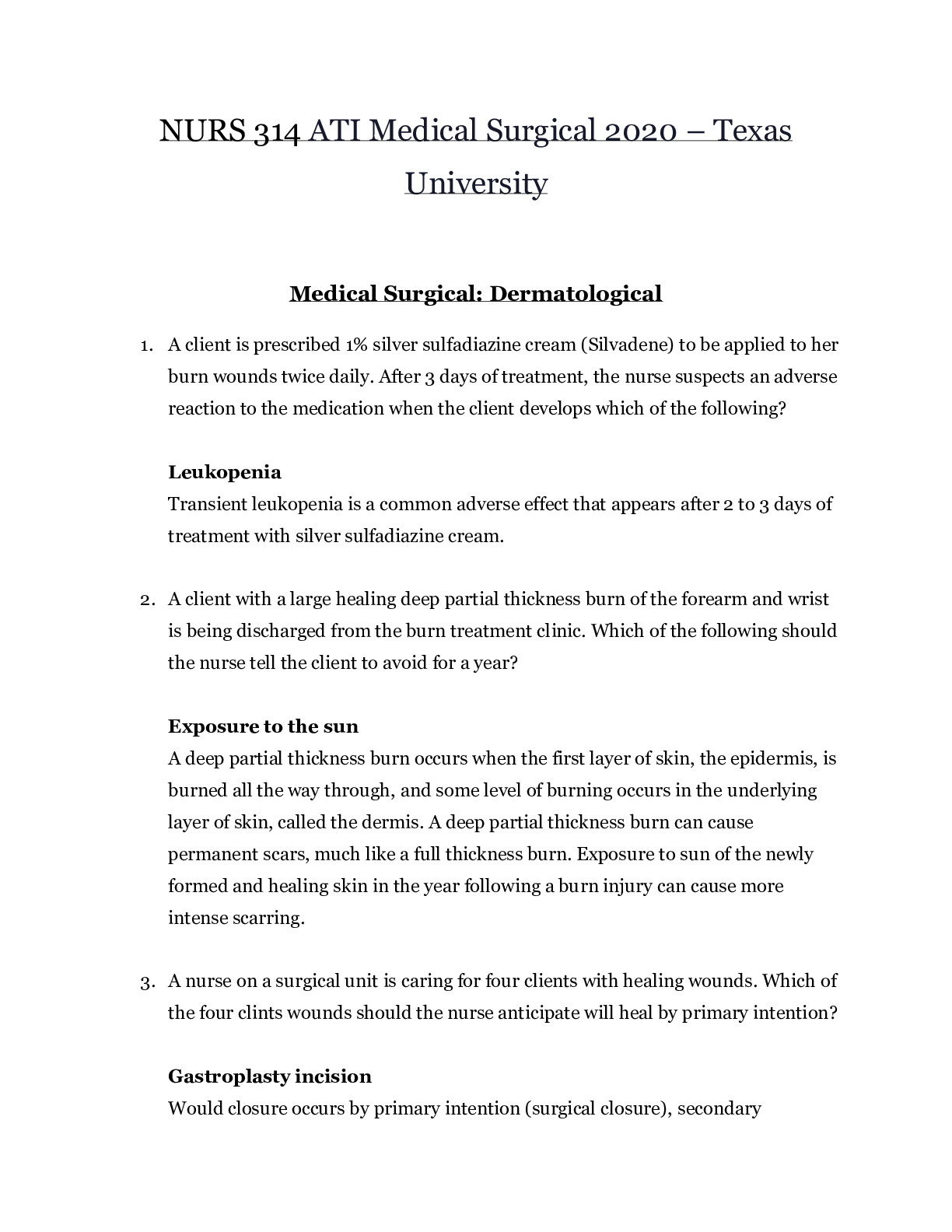
Reviews( 0 )
Document information
Connected school, study & course
About the document
Uploaded On
Aug 22, 2020
Number of pages
53
Written in
Additional information
This document has been written for:
Uploaded
Aug 22, 2020
Downloads
0
Views
84

 – Chamberlain College of Nursing.png)

 – Chamberlain College of Nursing.png)
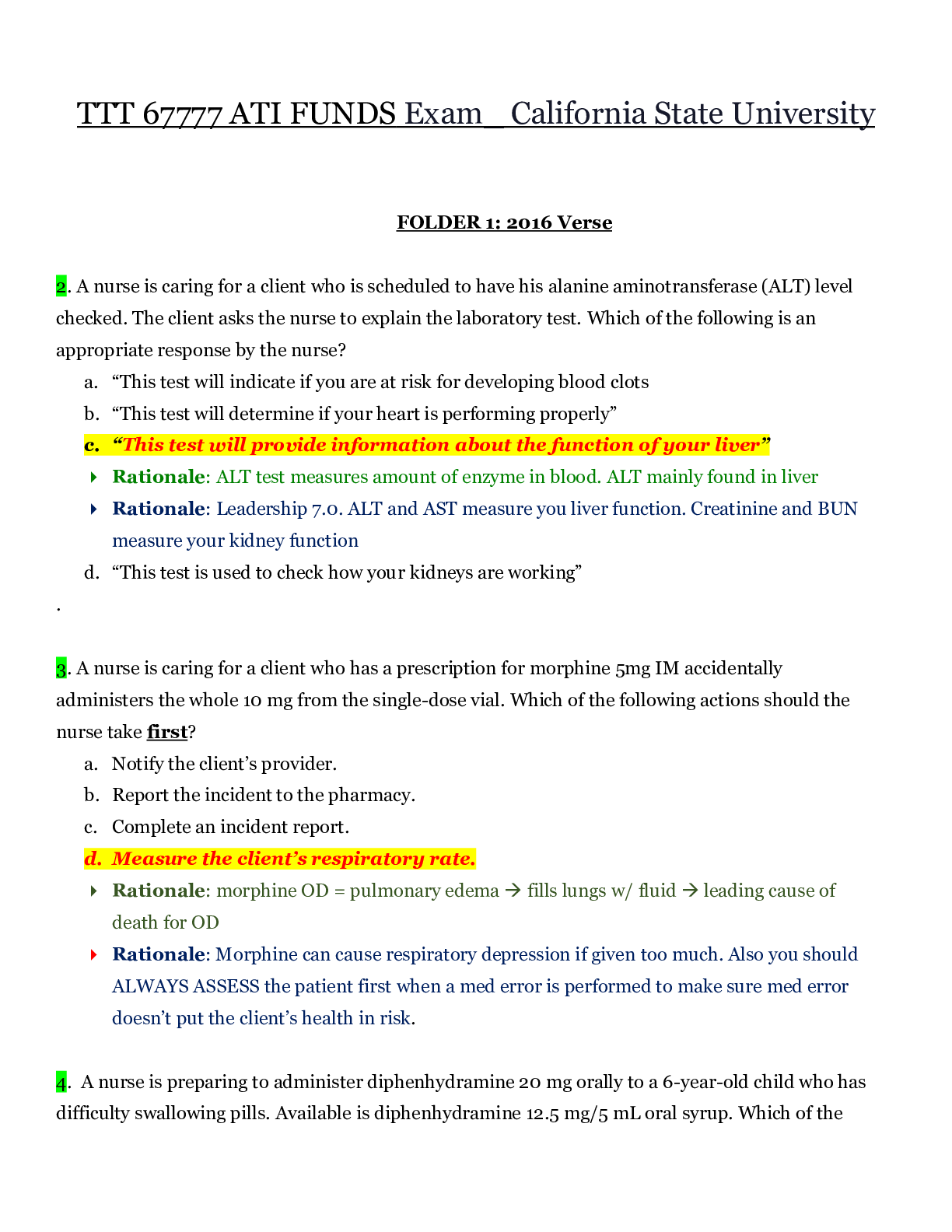

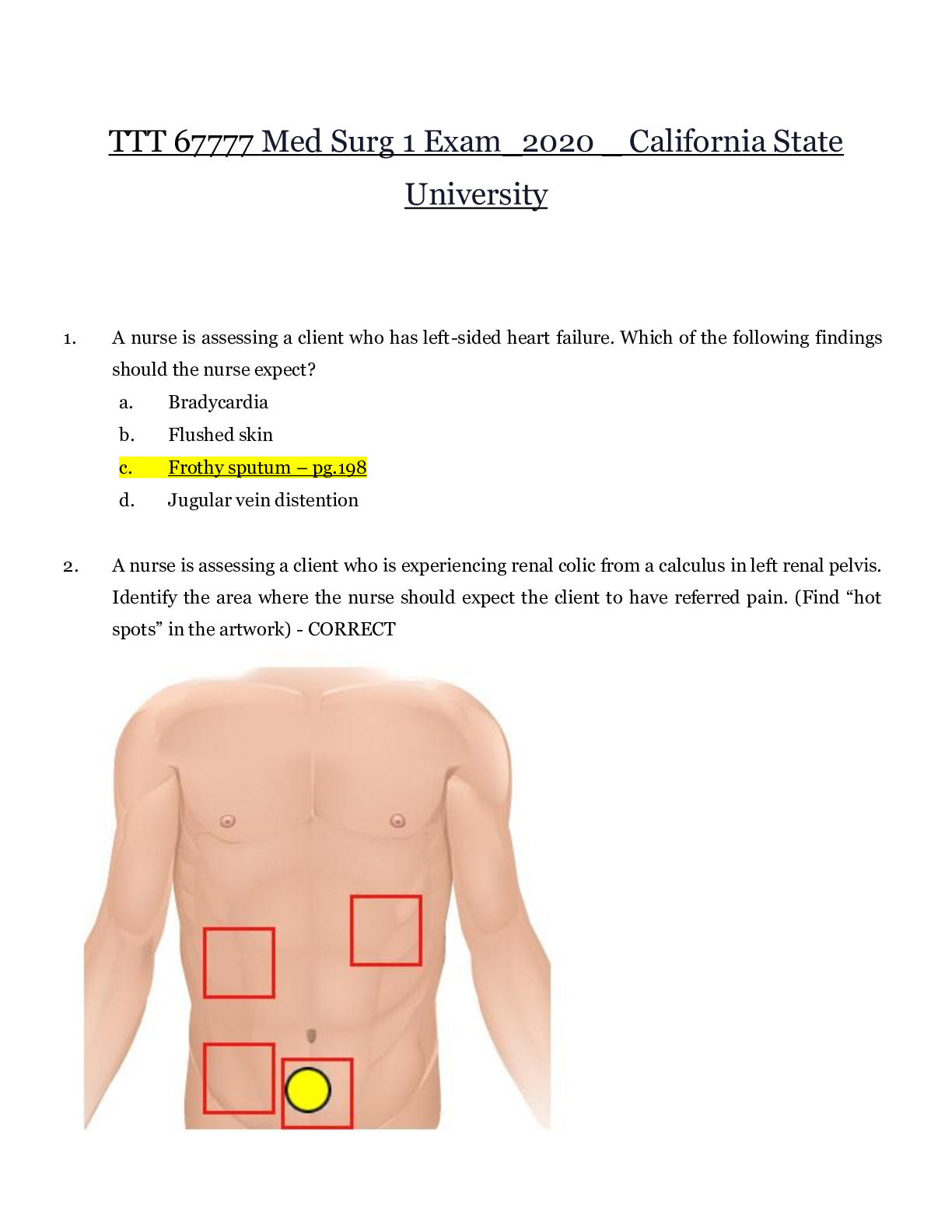
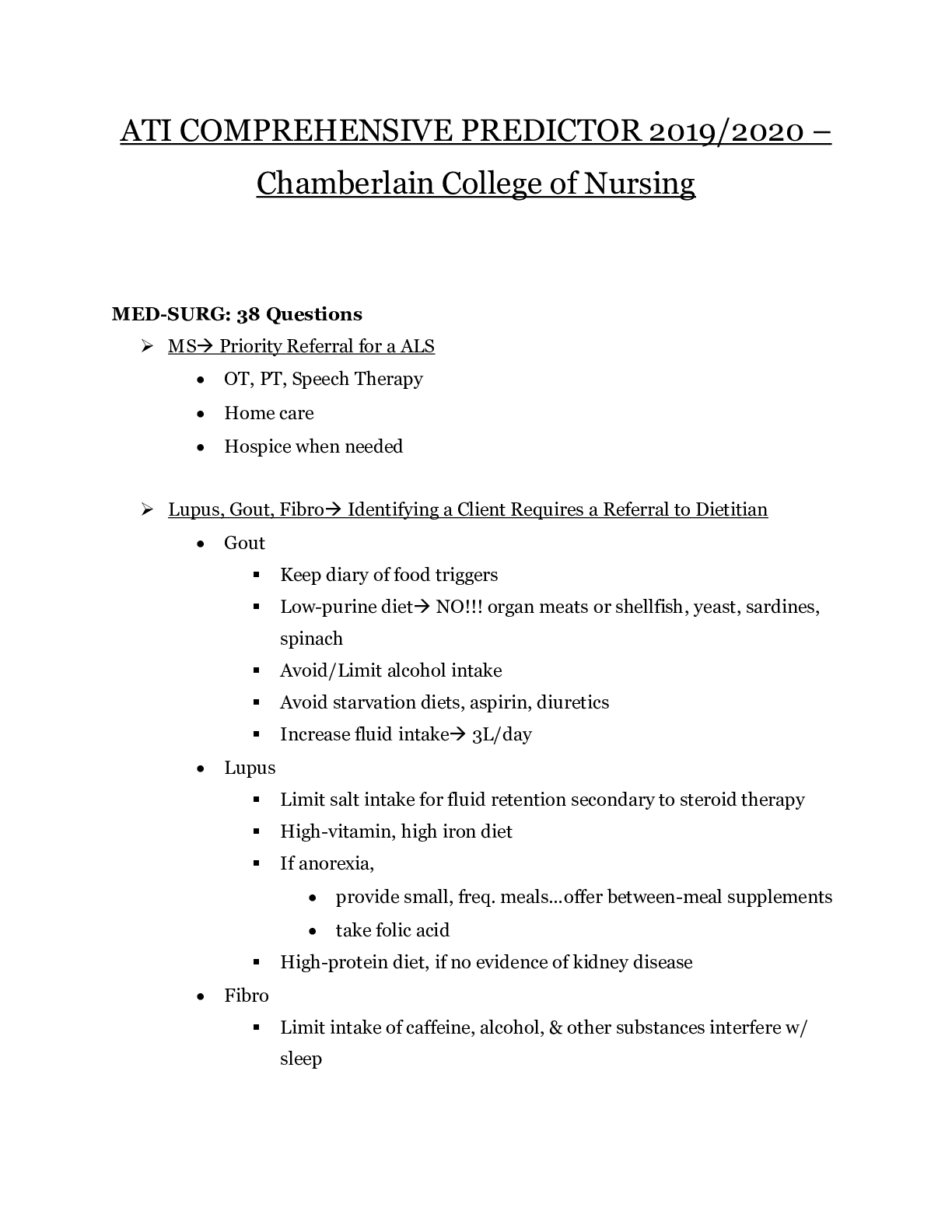
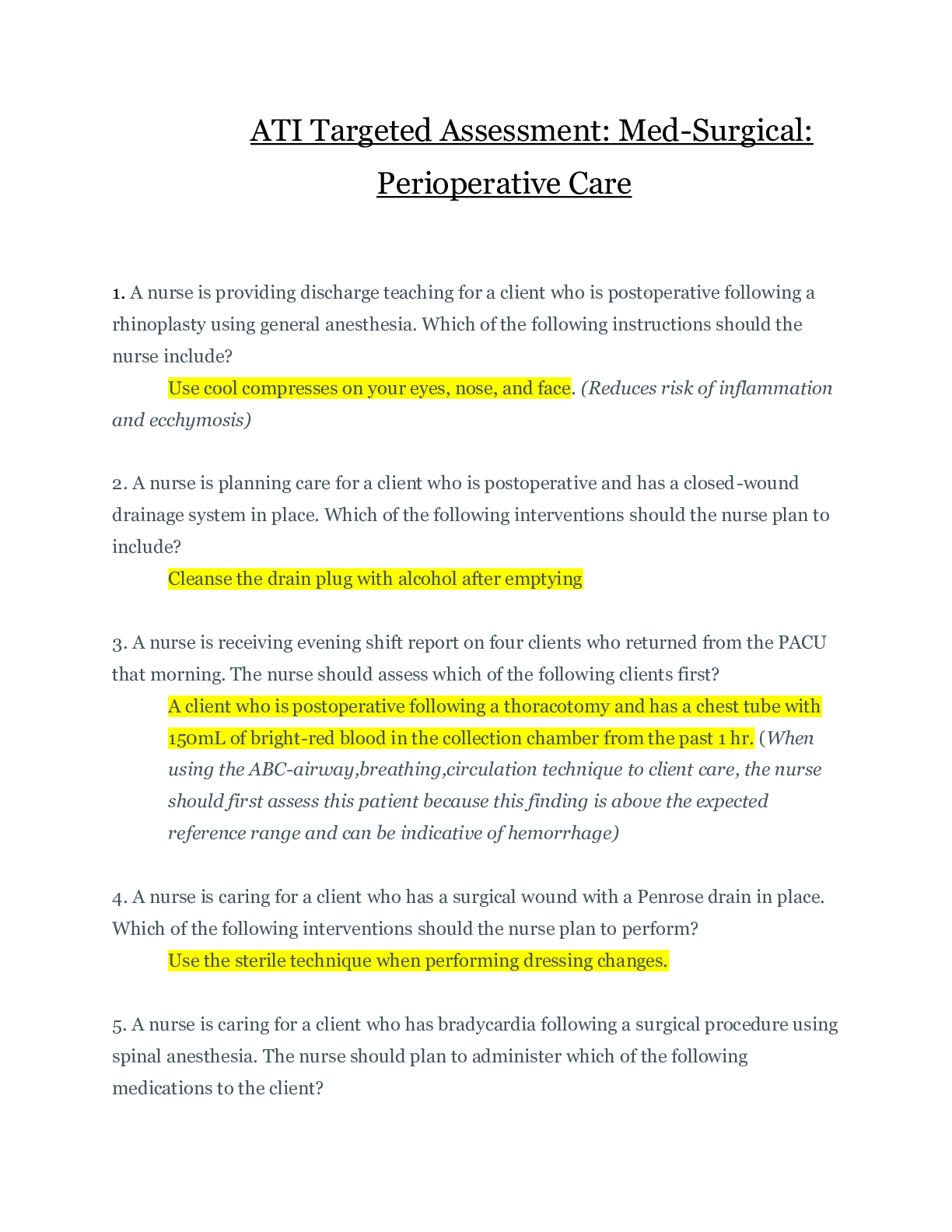

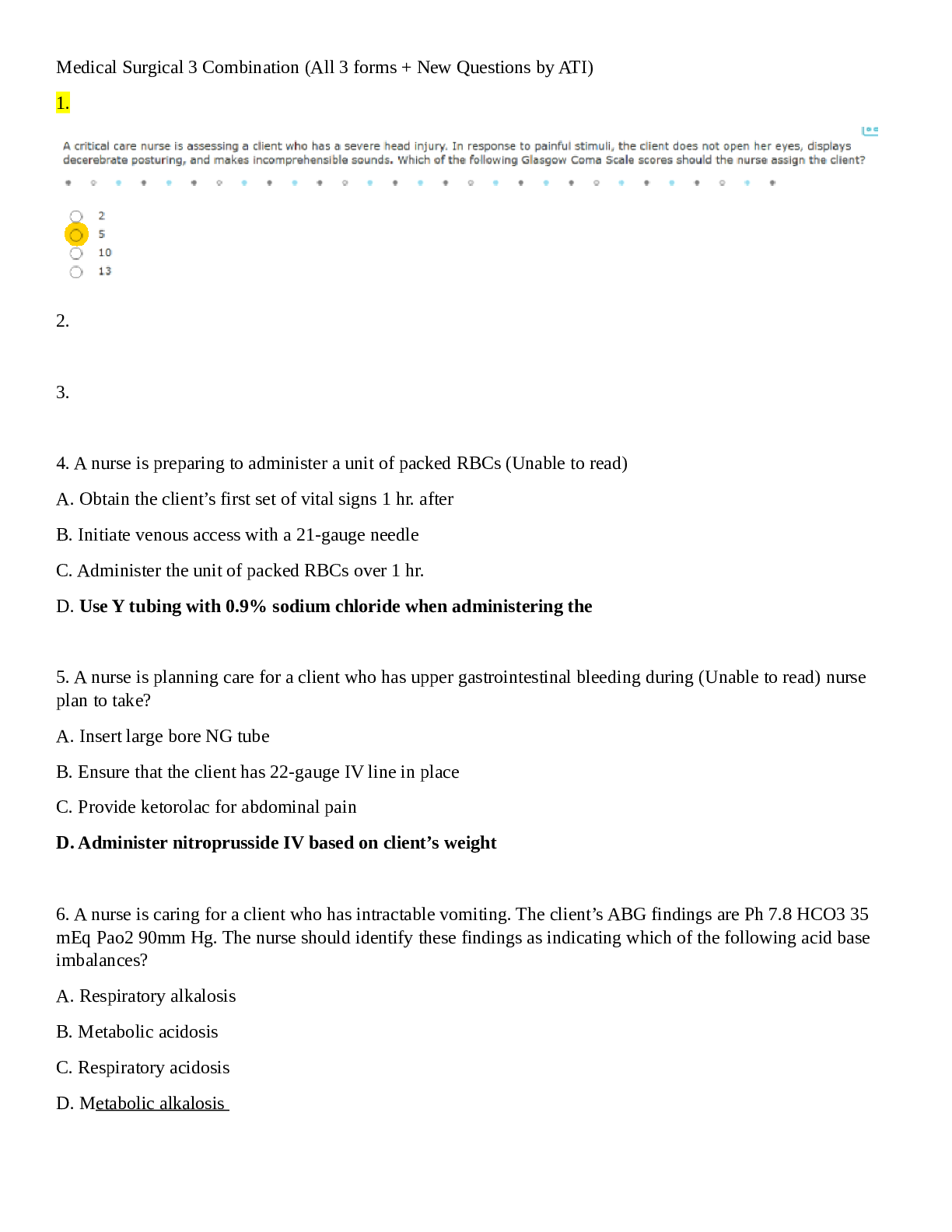
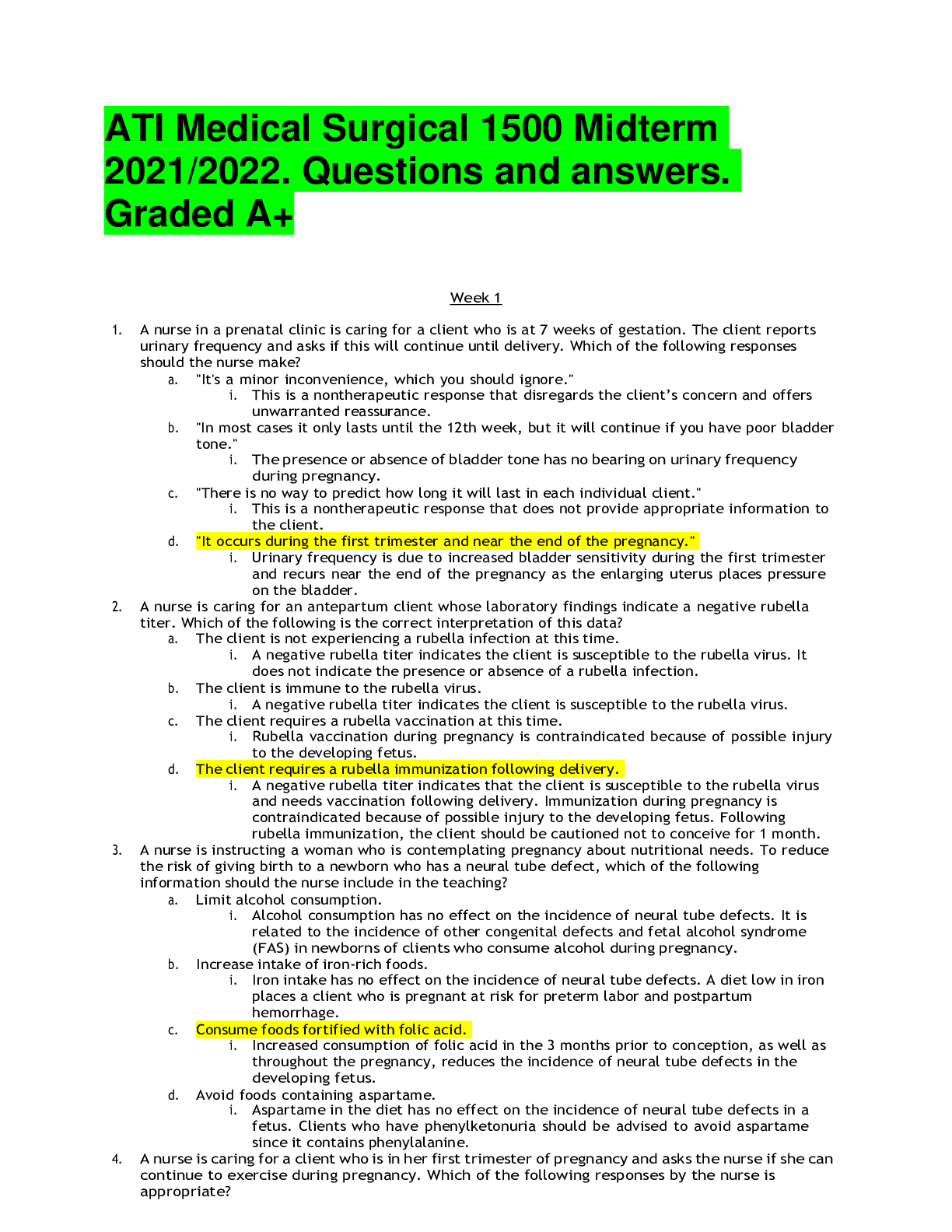
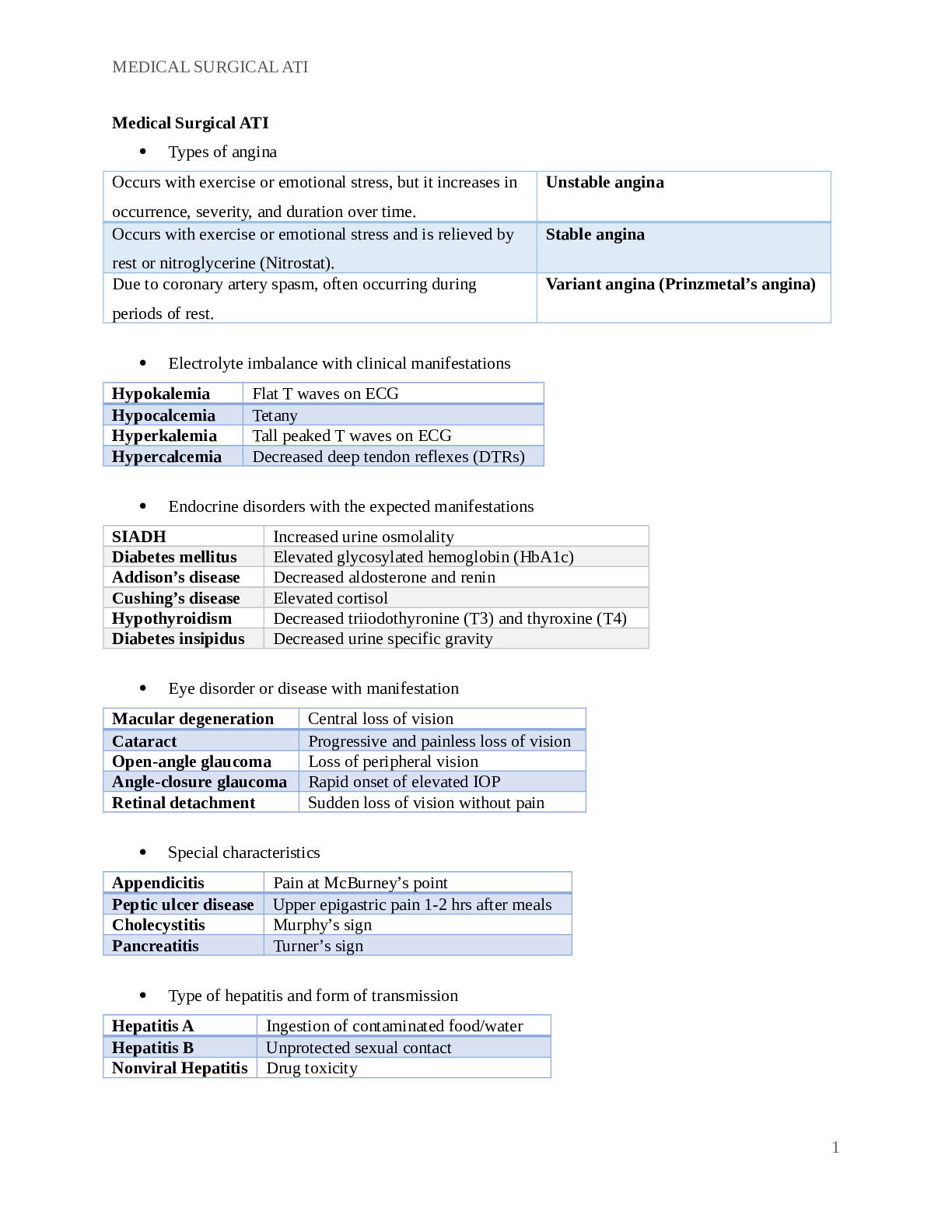
.png)
